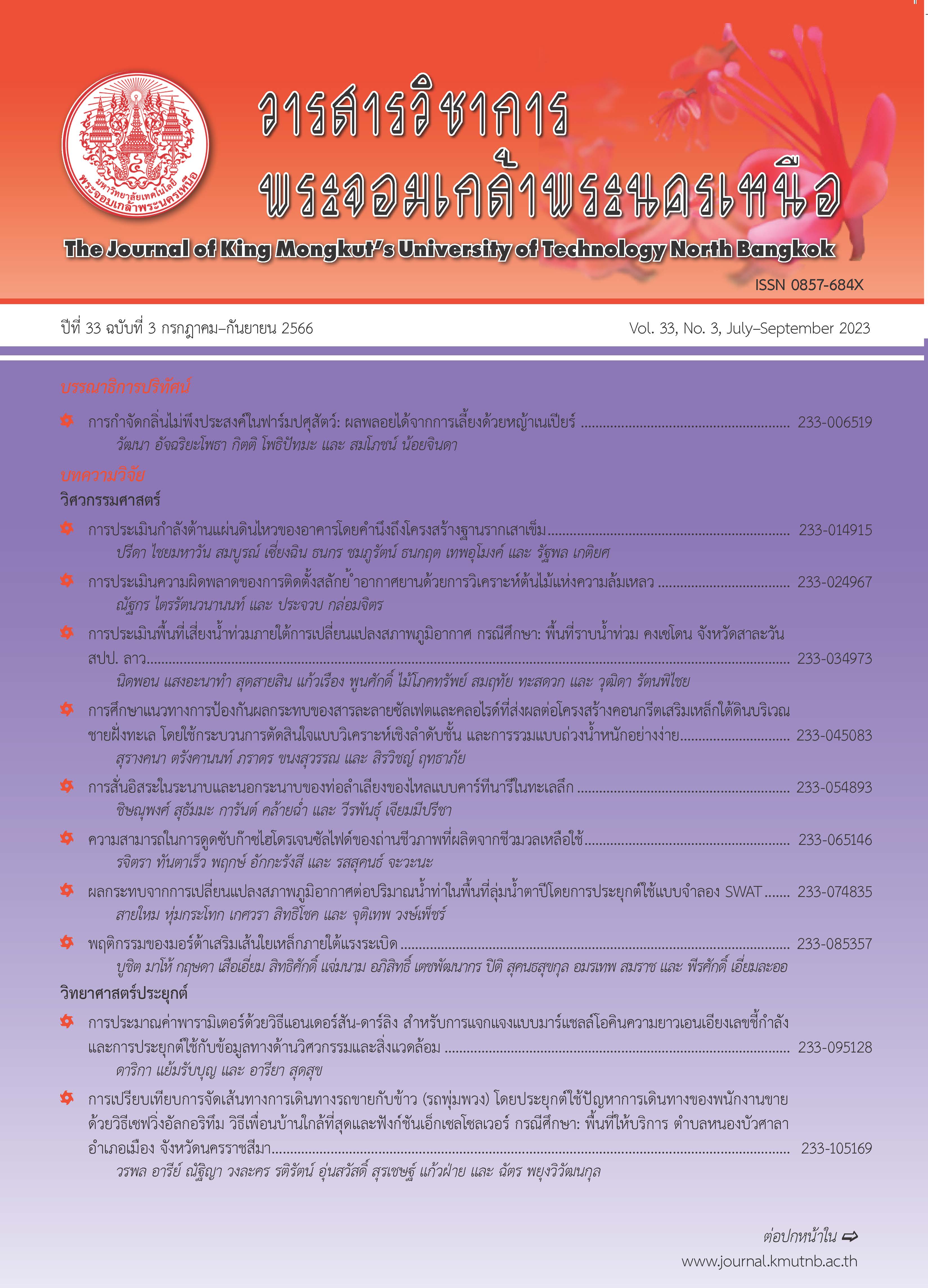การกำจัดกลิ่นไม่พึงประสงค์ในฟาร์มปศุสัตว์: ผลพลอยได้จากการเลี้ยงด้วยหญ้าเนเปียร์
Main Article Content
บทคัดย่อ
กลิ่น (สารระเหยง่าย) เป็นสิ่งที่รับรู้ได้โดยการดม มนุษย์สามารถจำแนกกลิ่นออกเป็นสองกลุ่มใหญ่ ๆ คือ กลิ่นหอมและกลิ่นเหม็น ตามอารมณ์และความรู้สึกซึ่งสังเกตได้จากงานประเพณีต่าง ๆ เช่น กลิ่นของงานรื่นเริงจะเป็นเอสเทอร์ของเทอร์พีนแอลกอฮอล์ (Esters of Terpene Alcohols) จากดอกกุหลาบที่มีสีสดใส [1] ทำให้มนุษย์มีความรู้สึกสดชื่นจิตใจเบิกบาน ส่วนกลิ่นของงานอวมงคลในบางศาสนาจะแตกต่างออกไปอย่างสิ้นเชิง โดยจะเป็นกลิ่นของธูป (กลิ่นกำยาน) และกลิ่นเอสเทอร์ สายยาวผสมกับแอลดีไฮด์จากดอกซ่อนกลิ่น ทำให้มนุษย์มีความรู้สึกหดหู่และปล่อยวาง [2]–[3] อย่างไรก็ตาม ความเคยชินอาจทำให้มนุษย์ยอมรับในกลิ่นนั้น ๆ ได้ เช่น คนเอเชียจำนวนไม่น้อย ยอมรับและคุ้นเคยกับกลิ่นทุเรียนสุก ในขณะที่คนทางตะวันตกบอกว่าทุเรียนสุกมีกลิ่นเหม็น หรือคนที่มีบ้านเรือนตั้งอยู่ใกล้กับกองขยะก็จะคุ้นชินกับกลิ่นของขยะจนเกิดเป็นความเคยชิน ดังนั้น จะเห็นได้ว่ากลิ่นมีอิทธิพลต่อจิตใจและอารมณ์ จนมีผู้นำเอาศาสตร์ ของกลิ่นมาบำบัดภาวะจิตของมนุษย์ ที่เรียกว่าการบำบัดด้วยกลิ่น (Aroma Therapy) [4]–[5] อย่างไรก็ตาม สภาพสังคมโลกในปัจจุบัน มีการเพิ่มจำนวนของประชากรขึ้นอย่างรวดเร็ว ทำให้มีการพัฒนาทางด้านเศรษฐกิจควบคู่ กันไปจนส่งผลให้เกิดมลภาวะทางกลิ่นขึ้นมามากมาย ยกตัวอย่างเช่น การทำฟาร์มเลี้ยงหนู (Rat Farming) เป็นอุตสาหกรรมครอบครัว
Article Details

อนุญาตภายใต้เงื่อนไข Creative Commons Attribution-NonCommercial-NoDerivatives 4.0 International License.
บทความที่ลงตีพิมพ์เป็นข้อคิดเห็นของผู้เขียนเท่านั้น
ผู้เขียนจะต้องเป็นผู้รับผิดชอบต่อผลทางกฎหมายใดๆ ที่อาจเกิดขึ้นจากบทความนั้น
เอกสารอ้างอิง
M. Shalit, I. Guterman, H. Volpin, E. Bar, T. Tamari, N. Menda, Z. Adam, D. Zamir, A. Vainstein, D. Weiss, E. Pichersky, and E. Lewinsohn, “Volatile ester formation in roses. Identification of an acetyl-coenzyme A. geraniol/citronellol acetyltransferase in developing rose petals,” Plant Physiology, vol. 131, no. 4, pp. 1868–1876, 2003.
A. Rodyoung, K. Sa-nuanpuag, C. Wongs-Aree, and M. Buanong, “Volatile releasing patterns of tuberose flowers (Polianthes tuberosa L.) at different maturities and diurnal times of the day,” Acta Horticulturae, vol. 1088, pp. 307–311, 2015.
J. C. Fragoso-Jimenez, E. C. Lugo-Cervantes, M. Estarrón-Espinoza, G. A. Castillo-Herrera, R. Barba-Gonzalez, M. C. Castañeda-Saucedo, and E. Tapia-Campos, “Volatile compounds in flowers of Polianthes genus,” Acta Horticulturae, vol. 1288, pp. 219–224, 2020.
F. Barati, A. Nasiri, N. Akbari, and G. Sharifzadeh, “The effect of aromatherapy on anxiety in patients,” Nephro-Urology Monthly, vol. 8, no. 5, article no. e38347, 2016.
D. Halder, B. B. Barik, R. K. Dasgupta, and S. Deb Roy, “Aroma therapy: An art of healing,” Indian Research Journal of Pharmacy and Science, vol. 5, no. 3, pp. 1540–1558, 2018.
Kasettumkin. (2022, October 9). Rice field rat raising in a circle cement pond is a popular career and good profit. [Online] (in Thai). Available: https://kasettumkin.com/agriculturenews/ article_12105
OPSMOAC. (2022, October 9). Raising “rice field rat” in home style is small investment and fast return. [Online] (in Thai). Available: https://www.opsmoac.go.th/chainat-clippreview- 421391791824
Kasettumkin. (2022, October 9). Young man left the salary of eighty thousand to raise the rice field rat for two hundred thousand per month. [Online] (in Thai). Available: https:// www.komchadluek.net/news/430390
B. Chumchit and S. Sriwilai, “Rat,” Weekly Pest Alert News, vol. 16, no. 57, pp. 1–3, 2018. (in Thai)
V. Herbreteau, J.-P. Gonzalez, H. Andrianasolo, P. Kittayapong, and J.-P. Hugot, “Mapping the potential distribution of Bandicota indica, vector of zoonoses in Thailand, by use of remote sensing and geographic information systems (a case of Nakhon Pathom Province),” The Natural History Journal of Chulalongkorn University, vol. 5, no. 2, pp. 61–67, 2005.
Y. Chaval, S. Waengsothorn, S. Morand, J. F. Cosson, and J. Claude, “A new taxonomic toolkit for identification of two sympatric species of Bandicota (Rodentia: Muridae) from mainland Southeast Asia,” Mammalia, vol. 80, no. 4, pp. 425–439, 2016.
K. Chaisiri, S. Morand, and A. Ribas, “Notocotylus loeiensis N. sp. (Trematoda: Notocotylidae) from Rattus losea (Rodentia: Muridae) in Thailand,” Parasite, vol. 18, no. 1, pp. 35–38, 2011.
H. Moniuszko, K. Wojnarowski, and P. Cholewinska, “Not only Leptotrombidium spp. an annotated checklist of chigger mites (Actinotrichida: Trombiculidae) associated with bacterial pathogens,” Pathogens, vol. 11, 1084, 2022.
Thevanoon. (2021, October 15). “NATPIER” offensive odor eliminating spray. [Online] (in Thai). Available: https://www.thevanoon. co.th/2021/10/natpier.html
Thevanoon. (2022, October 9). What is napier grass? [Online] (in Thai). Available: https:// www.thevanoon.co.th/ 2021/10/blog-post_8. html
P. Manokhoon and T. Rangseesuriyachai, “Effects of salt-assisted (ferric chloride) steam versus salt-assisted microwave pretreatments on delignification and morphology of napier grass (Pennisetum purpureum),” KMUTT Research and Development Journal, vol. 43, no. 4, pp. 529–540, 2020 (in Thai).
A. T. Negawo, A. Teshome, A. Kumar, J. Hanson, and C. S. Jones, “Opportunities for napier grass (Pennisetum purpureum) improvement using molecular genetics,” Agronomy, vol. 7, 28, 2017.
C. Sawatdeenarunat, R. Nirunsin, and S. Chaiprapat, “Enhanced volatile fatty acids production from Napier grass (Pennisetum purpureum) using micro-aerated anaerobic culture,” Songklanakarin Journal of Science and Technology, vol. 43, no. 6, pp. 1793–1799, 2021.
C . V i r u n a n o n , J . P u a n g k a e w , a n d W. Chulalaksananukul, “Denitrifying bacteria and the roles in problem solving of environmental pollution,” Journal of Agriculture, vol. 27, no. 3, pp. 305–315, 2011.
N. K. Shin, Z. M. Zin, N. M. Maidin, M. A. A. Abdullah, M. K. Zainol, “Effect of drying temperatures on antioxidant properties of Napier grass (Pennisetum purpureum). Asian Journal of Agriculture and Biology, vol. 7, no. 1, pp. 39–48, 2019.
P.-J. Tsai, S.-C. Wu, and Y.-K. Cheng, “Role of polyphenols in antioxidant capacity of napiergrass from different growing seasons,” Food Chemistry, vol. 106, pp. 27–32, 2008.

